Jinlong Bridge in Yongsheng County, Lijiang
Overview
- Chinese Name: 永胜县金龙桥
- English Name: Jinlong Bridge in Yongsheng County, Lijiang
On the Jinsha River section between Da’an Township in Yongsheng County and Qihe Township in the ancient city district of Lijiang, Yunnan Province, there is a 150-year-old iron cable bridge—Jinlong Bridge. For centuries, it has witnessed the prosperity of commerce between Lijiang and Yongsheng, historical changes, and transportation evolution, serving as a key pass on the Tea Horse Road connecting Sichuan, Yunnan, and Tibet.
Historical Significance
Over time, with societal development, Jinlong Bridge has gradually faded from people’s view, becoming a historical and cultural heritage and a national key cultural relic protection unit.
Location and Structure
Located near Zili Village in Da’an Township, Yongsheng County, Jinlong Bridge is also known as Zili Bridge. It spans the Jinsha River Gorge, 75 kilometers east of Yongsheng County, 45 kilometers west of Lijiang City, and adjacent to Heqing County in the south. It serves as a crucial transportation hub for the three counties, with imposing mountains, deep valleys, and an impressive natural landscape.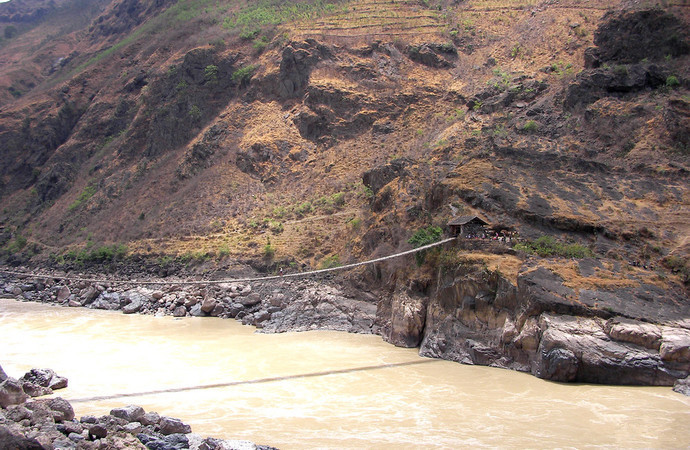
Scenic Beauty
Looking up, you’ll see towering peaks and sharp rocks piercing the sky. From the river to the mountain tops, the elevation difference is 200 meters, creating a breathtaking view of “clouds touching the sky at the mountain tops and the great river flowing like a silver thread.”
Standing on the bridge, the swaying surface feels like a moving swing. Looking down, the rushing river flows turbulently, with waves crashing against the banks, creating a thrilling and awe-inspiring scene.
Historical Challenges
Historically, the location of Jinlong Bridge has always been a critical passage. Before the bridge was built, locals could only cross the river using small wooden boats or leather rafts, which were unsafe due to the narrow and rapid river. Accidents were frequent.
Eventually, the Naxi, Yi, Lisu, Han, and other ethnic groups invented the zipline. They tied large bamboo ropes to giant rocks on both sides of the river and used zipline tubes to cross, leading to the area being known as Bamboo Rope Crossing or Zipline Crossing. However, the ziplines were also dangerous, and any slip could result in falling into the river. This prompted the construction of a safer bridge.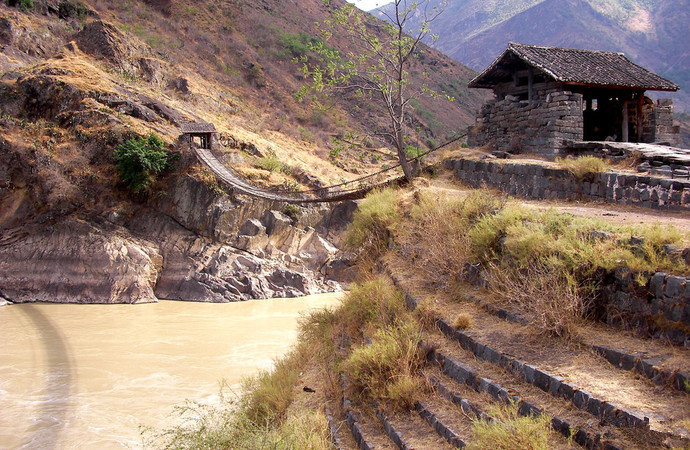
Construction History
The exact construction date of the first Zili Bridge is unknown. According to the “Yunnan General Annals” from the Ming Wanli period, there was an ancient bamboo suspension bridge over the river. This bridge was unstable and required new bamboo ropes every one to two years. Later, people replaced the bamboo bridge with an iron cable bridge. The current Zili Iron Cable Bridge was built in the second year of the Guangxu reign (1876), funded by Jiao Zonghan from Heqing, who donated 100,000 taels of silver. The bridge took four years to complete.
According to the “Newly Compiled Yunnan Annals,” Jiao Zonghan built the bridge after escaping an attack at Jinsha River. He vowed to construct the bridge if he survived, and later fulfilled his promise by funding the construction. The west end of the bridge has an inscription commemorating his contribution.
Plaques and Inscriptions
Plaques on both ends of the bridge record the details of its construction: “In the fifth year of Guangxu, with the imperial bestowment of the Yellow Horse Jacket, Jiao Zonghan was appointed Governor of Yunnan and named the bridge Jinlong Bridge.” The name “Jinlong Bridge” is prominently displayed in gold characters on a black background, showing grandeur and historical charm. The plaques still hang at the bridge’s entrance.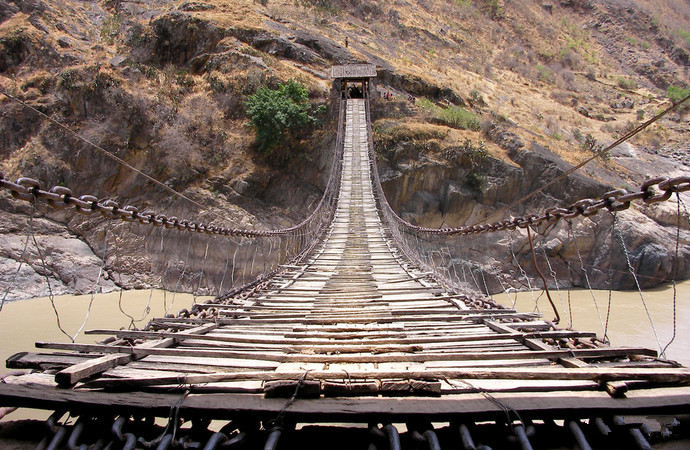
Architectural Details
Jinlong Bridge has a span of 92 meters, a width of 3.5 meters, and a total length of 131.6 meters. It is supported by 18 hand-forged iron chains, each made of over 500 rings. Sixteen chains form the base, covered with wooden planks, and two chains on each side serve as handrails. Each chain is five inches wide and weighs over eight pounds, making the bridge a testament to the craftsmanship of the builders.
The bridge towers at both ends are constructed with six-sided stone slabs, forming massive piers with intricate carvings and solid construction. The towers feature stone block walls, ancient pine pillars, tiled roofs, stone steps, and thick wooden doors, serving as guard posts.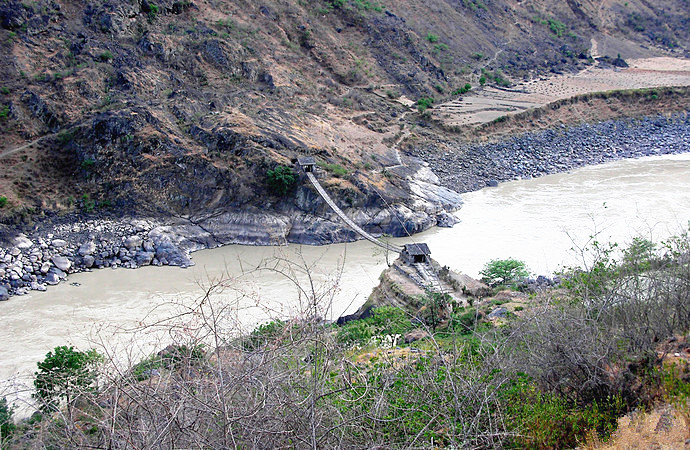
Construction Efforts
Building materials were transported manually, with iron chain rings made in the county towns and carried to the river. A mule could carry six rings, while a donkey could carry two, taking two days to reach the riverbank. The rings were then forged into seamless iron chains on-site, reflecting the immense effort and skill required for construction.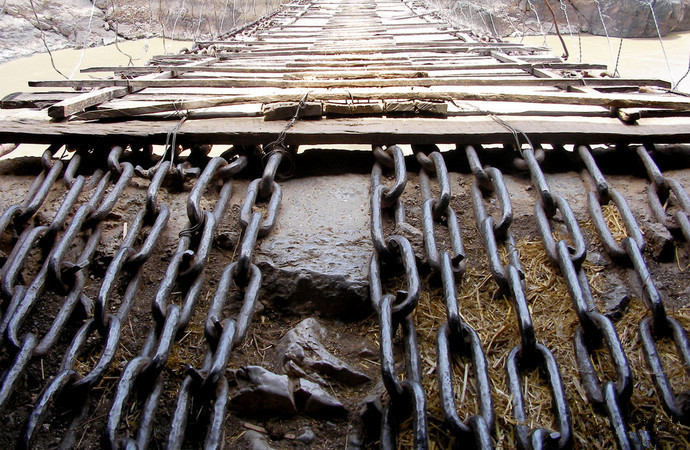
Modern Development
Jinlong Bridge’s west end is at Xiaojin’an Village in Qihe Township, Lijiang, once a relay station on the Tea Horse Road. The village is preserved and being developed into a traditional Naxi village for tourism.
Beyond Jinlong Bridge lies the Twelve Railings Slope, a winding path with breathtaking views of Lijiang. The bridge facilitated trade and cultural exchange among Yongsheng, Lijiang, and Heqing counties, becoming a vital route for merchants and travelers.
In 1982, the Liyong Highway was completed, with the modern Jin’an Bridge built five kilometers upstream, marking the end of Jinlong Bridge’s active use. However, it remains a historical monument, part of the Tea Horse Road, standing tall after 150 years of weathering, a testament to Yunnan’s rich cultural heritage.















